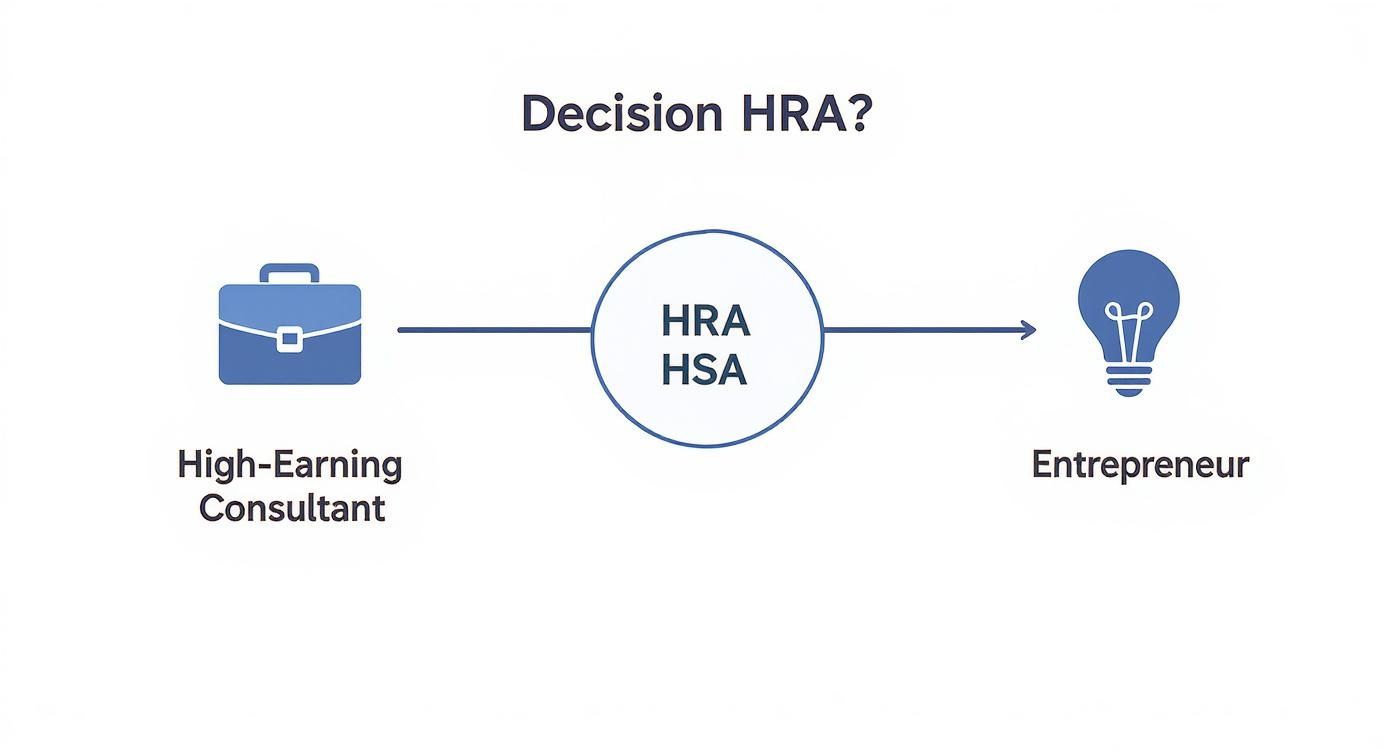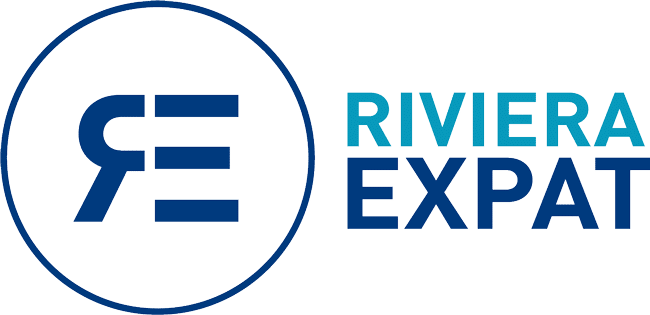The fundamental difference between a Health Reimbursement Arrangement (HRA) and a Health Savings Account (HSA) comes down to two critical concepts: ownership and funding.
An HRA is an employer-funded arrangement that the company owns and controls. Consider it a formal commitment from your employer to reimburse qualified medical expenses. In sharp contrast, an HSA is an employee-owned account, funded by you and, in many cases, your employer, which functions as a personal investment vehicle dedicated to healthcare. This distinction is paramount for strategic financial planning.
HRA vs HSA: An Executive Summary for Strategic Healthcare Planning

For high-net-worth professionals, selecting a healthcare account is not merely about choosing a benefit—it is a critical component of strategic wealth management. While Health Reimbursement Arrangements (HRAs) and Health Savings Accounts (HSAs) may appear similar, they operate under entirely different financial philosophies. An incorrect choice can result in a significant loss of financial autonomy and growth potential.
An HRA is, in essence, a reimbursement commitment from your employer. The company establishes an annual limit, you incur qualified medical expenses, and they reimburse you. The company owns the arrangement, dictates the terms, and retains any unused funds if you leave the organization or do not utilize the full amount. It is a temporary benefit, not a personal asset.
An HSA, conversely, is a powerful financial instrument that belongs entirely to you. To establish one, you must first be enrolled in a high-deductible health plan (HDHP). The funds are yours to retain, invest, and grow in perpetuity. It is portable between employers and transitions with you into retirement.
HRA vs HSA: Key Distinctions at a Glance
To provide clarity, here is a direct comparison of the core differences. This table offers a concise reference for determining which account structure aligns with your long-term financial objectives.
| Feature | Health Reimbursement Arrangement (HRA) | Health Savings Account (HSA) |
|---|---|---|
| Account Ownership | Owned by the employer. | Owned by the employee. |
| Funding Source | Funded exclusively by the employer. | Funded by both the employee and employer. |
| Portability | Stays with the employer if you leave the job. | Fully portable; you retain the account and its funds for life. |
| Contribution Rollover | Typically, funds do not roll over (employer's discretion). | Funds always roll over year after year, enabling compound growth. |
| Investment Potential | None. It is a reimbursement arrangement only. | Yes. Funds can be invested in stocks, bonds, and other securities, similar to a 401(k). |
| Tax Advantage | Tax-free reimbursements for employees. | The powerful triple-tax advantage: tax-deductible contributions, tax-free growth, and tax-free medical withdrawals. |
This table makes one point unequivocally clear: the difference in ownership is paramount. An HRA is a benefit tied to your current role. An HSA is a portable, appreciating asset that becomes a core component of your long-term wealth strategy.
For expatriate professionals, the nuances of these accounts are even more critical when managing global health needs. The right choice can dramatically impact your financial autonomy and capacity for long-term health and wealth accumulation. Understanding how these accounts integrate with your broader coverage is key, which often means exploring options for international private medical insurance to ensure there are no vulnerabilities in your protection.
How HRAs and HSAs Actually Work
To truly appreciate the difference between an HRA and an HSA, one must examine their mechanics. These are not simply two variations of the same concept; their legal and financial structures are fundamentally different, which dictates how they are funded, how funds are accessed, and how they can be utilized. Aligning one of these accounts with your financial goals requires a precise understanding of these mechanics.
At its core, a Health Reimbursement Arrangement (HRA) is a commitment, not an account. It is a formal pledge from your employer to reimburse qualified medical expenses up to a predetermined annual limit. The employer establishes all the rules of engagement.
The HRA: An Employer-Owned Framework
The HRA is not a singular product but a category of employer-sponsored benefits, each with a specific use case and regulatory framework.
- Qualified Small Employer HRA (QSEHRA): This is designed for small businesses—specifically, those with fewer than 50 full-time equivalent employees. A QSEHRA allows a small company to offer a tax-advantaged health benefit without sponsoring a full group health plan. The employer sets a monthly allowance, which employees can use for their own health insurance premiums and other qualified medical costs.
- Individual Coverage HRA (ICHRA): The ICHRA is far more flexible and can be utilized by companies of any size. It effectively decouples the health benefit from a specific group plan. The business provides tax-free funds that employees must use to purchase their own insurance on the individual market.
Regardless of the type, the process is consistent: reimbursement. You pay for a medical expense out-of-pocket, submit the required documentation, and your employer reimburses you from their business assets. You never interact with a personal account that you can manage or invest.
Here's the critical takeaway: HRAs are defined by employer control. The company determines the allowance, the scope of covered expenses, and whether any unused funds roll over to the next year. This structure provides the business with predictable costs but offers the employee very little autonomy.
The HSA: A Personal Financial Asset
A Health Savings Account (HSA), on the other hand, is a true financial asset. It is a personal savings and investment account that you own, analogous to an IRA or a 401(k), but it offers tax advantages that are unmatched.
The one non-negotiable prerequisite is that an HSA must be paired with a High-Deductible Health Plan (HDHP). You cannot contribute to an HSA unless you are enrolled in a qualifying HDHP. This structure is designed to encourage individuals to become more engaged and discerning consumers of their own healthcare.
The true power of the HSA lies in its triple-tax advantage:
- Tax-Deductible Contributions: The capital you contribute reduces your taxable income for the year.
- Tax-Free Growth: You can invest the funds in stocks, bonds, and mutual funds, and all appreciation is completely tax-free.
- Tax-Free Withdrawals: As long as you use the funds for qualified medical expenses, withdrawals are entirely tax-free.
This mechanical difference is profound. An HRA is a tool for managing today's medical expenses. An HSA is a powerful vehicle for building long-term, tax-free wealth that can cover healthcare costs now, in the future, and even serve as a supplementary retirement account.
Analyzing Funding, Contribution, and Ownership

This is where the fundamental architecture of these two accounts truly diverges. For a high-net-worth professional, the regulations governing funding and ownership are not mere details—they are the core determinants of the instrument's value. These factors determine whether you possess a temporary employee benefit or a permanent personal asset.
An HRA is a closed-loop system, entirely controlled by your employer. The company establishes the allowance, defines the rules, and contributes every dollar. It is their capital, their arrangement, their rules. This provides them with complete cost control but leaves you with zero capacity to contribute your own capital or cultivate a personal asset.
The HSA, conversely, is a dynamic financial tool. While your employer can contribute (a common incentive), the real power is derived from your ability to make your own pre-tax contributions. This is not merely a procedural difference; it represents a complete philosophical shift in who controls the capital and its long-term potential.
Funding and Contribution Dynamics
The flow of capital tells the entire story. With an HRA, the flow is unilateral: from the employer to you, but only as a reimbursement. You cannot supplement it or add your own funds to expand the benefit. Its value is fixed.
This is a critical distinction. The source of funding is one of the most significant differences between HRAs and HSAs. While HRAs are exclusively employer-funded, HSAs are designed for both employer and employee contributions, placing you firmly in control of your healthcare savings strategy. Further details on these funding mechanics and their long-term impact are available on the Employee Benefit Research Institute's website.
HSA contribution limits are established by the IRS annually and are a key lever for wealth accumulation. For 2024, those limits are:
- $4,150 for self-only coverage
- $8,300 for family coverage
Furthermore, if you are 55 or older, you can contribute an additional $1,000 "catch-up" contribution. This provision is specifically designed to help you accelerate savings as you approach retirement, effectively enhancing your HSA's function as a supplemental retirement fund.
The catch-up contribution is a significant strategic advantage for the HSA. It is a tool for late-stage wealth accumulation that simply does not exist within the HRA framework.
Account Ownership and Portability
This is the clear, uncrossable line between a temporary benefit and a permanent asset. An HRA belongs to your employer. The day you separate from service, the arrangement—and any remaining balance—stays with the company.
For professionals with high career mobility, this renders an HRA a short-term tool, not a long-term asset. It cannot follow you to your next engagement, and its funds cannot be integrated into your personal financial strategy beyond the current year.
An HSA, conversely, is your personal property. Every dollar within it is yours, irrespective of your employer. If you change jobs, the HSA moves with you, without restriction. This portability makes it a permanent part of your personal balance sheet.
The strategic power of this cannot be overstated. An HSA functions as a specialized, tax-advantaged investment account dedicated to your health. You can build it over your entire career to cover medical costs for the rest of your life, particularly in retirement when those costs are typically highest.
Qualified Expenses and Reimbursement Rules
Both account types permit tax-free withdrawals for qualified medical expenses as defined by the IRS—deductibles, copayments, dental care, vision care, and prescriptions.
However, the mechanism for accessing funds is entirely different. With an HRA, the process is reactive. You incur an expense, submit documentation, and await reimbursement from your employer.
An HSA places you in proactive control. Most are issued with a debit card, allowing you to pay for expenses directly at the point of service. However, the more sophisticated strategy is to not reimburse yourself immediately. You can pay for a medical expense out-of-pocket today, retain the receipt, and allow your HSA funds to grow tax-free for years—or even decades. You can then reimburse yourself from the account at a later date. This strategy effectively transforms today's medical bills into a catalyst for tomorrow's tax-free investment growth.
To crystallize these differences, a side-by-side comparison is useful. The table below details the key attributes that define the real-world operation of these accounts.
Comprehensive Feature Analysis HRA vs HSA
| Attribute | Health Reimbursement Arrangement (HRA) | Health Savings Account (HSA) |
|---|---|---|
| Who Owns the Account? | The Employer. Funds revert to the company upon termination. | The Employee. It is a portable personal asset. |
| Who Can Contribute? | Only the Employer. Employee contributions are not permitted. | Employee, Employer, and even third parties. |
| Annual Contribution Limits | No IRS limit; set at the employer's discretion. | 2024 IRS Limits: $4,150 (self), $8,300 (family). |
| Catch-Up Contributions | No. This feature does not exist for HRAs. | Yes. $1,000 annually for individuals age 55+. |
| Do Funds Roll Over? | Employer's choice. Unused funds often expire annually. | Yes. Funds never expire and roll over indefinitely. |
| Can Funds Be Invested? | No. The arrangement is for reimbursement only, not growth. | Yes. Funds can be invested in mutual funds, stocks, etc. |
| Health Plan Requirement | Can be paired with any group health plan. | Must be paired with a High-Deductible Health Plan (HDHP). |
| Portability | No. The account is tied to the current employer. | Yes. The account follows you to any future job or retirement. |
As this analysis demonstrates, the HRA serves a very specific, limited purpose defined by the employer. The HSA, in contrast, is a flexible, powerful financial tool that you own and control, making it a far superior vehicle for long-term wealth accumulation and healthcare planning.
Integrating Tax Benefits Into Your Wealth Strategy

Understanding the mechanics of these accounts is one matter, but integrating them into a sophisticated wealth strategy is an entirely different discipline. When viewed from a financial planning perspective, the core distinction between an HRA and an HSA is their tax treatment and its direct impact on long-term capital growth.
An HRA provides a very straightforward tax benefit. When you are reimbursed for a qualified medical expense, that capital is entirely tax-free. Your employer also benefits by deducting their contributions as a business expense. It is a clean, tax-efficient method for managing immediate healthcare costs.
However, the HRA's tax advantages effectively end there. It is a tool for reimbursement, not for wealth creation. This is where the HSA excels as a far more potent instrument for high-net-worth individuals.
The Unmatched Power of the Triple-Tax Advantage
The Health Savings Account operates at another level, courtesy of its renowned triple-tax advantage. No other investment vehicle—not a 401(k), not a Roth IRA—can match this powerful structure.
- Tax-Deductible Contributions: Every dollar you or your employer contributes to an HSA reduces your gross taxable income for the year.
- Tax-Free Growth: Once inside the account, your funds can be invested in stocks, bonds, and mutual funds. All capital gains and dividends accumulate completely tax-free.
- Tax-Free Withdrawals: You can withdraw funds at any time to pay for qualified medical expenses without incurring any tax liability.
This trifecta transforms the HSA from a simple health account into a top-tier, long-term investment vehicle. For a high-income earner, maximizing annual contributions is not just about covering future medical bills; it is a strategic maneuver to reduce your current tax liability while seeding a tax-free investment portfolio.
The HSA as a Supplemental Retirement Vehicle
The strategic value of an HSA becomes even more pronounced as you approach retirement. After reaching age 65, the withdrawal regulations change significantly. While withdrawals for medical costs always remain tax-free, you can now also withdraw money for any other reason—a vacation, a home renovation, or supplemental income—without the 20% penalty that applies to non-medical withdrawals for younger account holders.
For these non-medical withdrawals, you will only pay ordinary income tax, making the HSA function identically to a traditional IRA or 401(k). This dual-purpose capability is a strategic game-changer. It allows you to build a dedicated, tax-free fund for future healthcare needs (often a retiree's largest expense) while also creating a flexible, tax-deferred account for general retirement spending.
The scope of eligible expenses also sets them apart. HSAs allow you to save pre-tax dollars for an extensive list of qualified medical expenses, and those funds can be invested for tax-free growth. One recent report indicates that in 2023, approximately 22% of individuals under age 65 with private health insurance were enrolled in an HDHP with an HSA. In contrast, HRAs are for reimbursement only and lack an investment feature. You can find more trends in Health Savings Accounts in recent analyses.
Estate Planning and Legacy Considerations
The differences between an HRA and an HSA extend to estate planning. An HRA is your employer's property. Upon your death, any remaining funds are forfeited. There is zero legacy value for your heirs.
An HSA, however, is your personal property and becomes part of your estate. The treatment of the funds depends on your designated beneficiary:
- Spouse Beneficiary: If your spouse inherits the HSA, it simply becomes an HSA in their name. This preserves its tax-advantaged status for their own use, seamlessly continuing the benefits.
- Non-Spouse Beneficiary: If an individual other than your spouse inherits the account, it ceases to be an HSA. The fair market value of the account becomes taxable income to your beneficiary in the year of your death, and they receive the funds as a lump sum.
This distinction is critical for wealth transfer strategies. A well-funded HSA can be passed to a spouse, providing them with a continuous source of tax-free healthcare funding and investment growth.
Choosing the Right Account for Your Career Stage
Disregard the technical jargon for a moment. The true difference between an HRA and an HSA becomes apparent only when they are applied to real-world career scenarios. There is no single "best" account; the optimal choice is entirely dependent on your profession, your income, and your long-term financial objectives.
Let us examine a few scenarios to illustrate this. The needs of a seasoned executive are worlds apart from those of a startup founder.
The C-Suite Executive Scenario
Imagine a Chief Financial Officer at a large multinational corporation. Her compensation package is top-tier and includes a generous, employer-funded HRA that covers 100% of her family's out-of-pocket medical costs. Deductibles and copayments are all managed by the HRA.
For her, the HRA is a straightforward, high-value benefit. It is a powerful tool for eliminating current healthcare costs without requiring her to contribute anything. She is already maximizing contributions to her 401(k), deferred compensation plans, and personal brokerage accounts. She does not require another investment vehicle like an HSA.
The HRA performs its intended function perfectly: it pays for today's medical expenses, allowing her other assets to focus exclusively on long-term, aggressive growth.
The Entrepreneur and Business Owner Scenario
Now, consider an entrepreneur who has just launched a fintech startup with 20 employees. She cannot afford a traditional group health plan, but she needs to offer a competitive health benefit to attract top talent.
The ideal tool here is a Qualified Small Employer HRA (QSEHRA). This allows her to provide each employee with a fixed, tax-deductible monthly allowance to purchase their own health insurance. This strategy offers a meaningful benefit with predictable, manageable costs for her growing business.
Simultaneously, for her personal finances, she enrolls in a High-Deductible Health Plan (HDHP) and opens an HSA. She then contributes the maximum amount annually, treating the HSA less like a health fund and more like a superior, tax-advantaged investment account to build wealth completely separate from her company.
For a business owner, the key is separating the company's financial strategy from personal wealth accumulation. An HRA offers a cost-controlled solution for the business, while an HSA provides a powerful, portable asset for the individual.
The High-Earning Consultant Scenario
Finally, consider a high-earning management consultant at a global firm. His employer offers an Individual Coverage HRA (ICHRA), providing a substantial allowance that employees use to purchase their own insurance on the marketplace.
He leverages this brilliantly. He selects a bronze-level, HSA-qualified HDHP and uses the tax-free ICHRA funds to cover the monthly premiums. Because he is enrolled in an eligible plan, he can now open and fund his own Health Savings Account with his personal pre-tax dollars.
This is a masterclass in benefit optimization. The ICHRA pays for his insurance, transforming his HSA into a pure investment engine that can compound tax-free for decades. It is a personal asset that he owns completely and will follow him wherever his career leads.
This final point about ownership is critical. HRAs belong to the employer, meaning if you leave the company, you typically forfeit the funds. In stark contrast, an HSA is your personal property—it accompanies you when you change jobs, start a business, or retire. According to the 2023 Employer Health Benefits Survey from KFF, 29% of firms offering health benefits provided an HDHP with an HSA option. You can explore more of the survey’s findings on health savings accounts to see how this trend is growing.
Making the Right Call With Your Financial Advisor
Deciding between an HRA and an HSA is not simply a task to complete during open enrollment. It is a fundamental financial decision that integrates directly into your long-term wealth strategy. This conversation with your advisor must transcend a simple feature comparison; it is about aligning the appropriate tool with your personal financial architecture.
To ensure a correct decision, you must frame the discussion properly. The objective is to assess your specific circumstances against the entirely different financial philosophies that underpin each account.
Key Questions for Your Advisor
The conversation should distill down to three key areas: your immediate objectives, your career trajectory, and your desired level of active financial management.
- What is Your Top Priority? Are you seeking to minimize your immediate, out-of-pocket healthcare expenditures using your employer's capital? This points toward an HRA. Or is your primary objective to build a new, tax-advantaged asset class that can grow tax-free for decades? This is a compelling argument for an HSA.
- What Does Your Career Trajectory Look Like in 5 Years? If there is a high probability you will change employers, transition to consulting, or launch your own enterprise, the portability of a personal HSA is a significant advantage. An employer-owned HRA, by contrast, offers zero value the day you depart.
- Are You an Active Investor? The true power of an HSA is unlocked only when you actively manage its investment component to maximize growth. An HRA is entirely passive. Therefore, are you prepared to manage another investment account?
The core of the matter is this: Do you require a short-term tool for reimbursement or a long-term, portable vehicle for wealth creation? Your answer will guide you to the correct path.
To ensure you have the most productive conversation possible, it is beneficial to know what to look for when finding the right financial advisor to guide this type of strategic planning.
The decision tree below provides a visual representation of how different career moves might influence a high-earning professional's choice between these accounts.

As you can see, a professional’s current role and future aspirations—such as transitioning from consulting to entrepreneurship—are the true determinants of which account provides the superior strategic advantage.
Actionable Next Steps
Once you and your advisor have determined the best course of action, implementation is straightforward.
- If you're proceeding with an HSA: First, confirm your enrollment in a qualifying High-Deductible Health Plan (HDHP). Then, establish your HSA with a custodian known for solid, low-fee investment options. Your immediate next step should be to create a plan to maximize your annual contributions.
- If an HRA is the more suitable choice: Your task is to become an expert on your employer's specific plan. Ascertain the annual allowance, precisely which expenses are covered, and any rollover provisions. Then, create a meticulous system for tracking every eligible expense and submitting claims to ensure you do not leave any funds on the table. For expatriates, it is also critical to review your primary insurance policy; you can gain a better understanding of the details by reading our guide explaining expat medical insurance policy terms.
Frequently Asked Questions
Even for the most financially astute professionals, the fine print separating HRA and HSA accounts can raise specific and important questions. Mastering these edge cases is key to making these accounts work within a larger wealth and healthcare strategy. Let us address a few of the most common inquiries.
Can You Have an HRA and an HSA Simultaneously?
In most situations, the answer is a firm no. The IRS considers a standard HRA that covers a broad range of medical expenses as "other health coverage," which disqualifies you from making HSA contributions.
There are, however, a few specific exceptions. An employer can establish a "limited-purpose" HRA that operates alongside an HSA. This type of HRA is strictly limited to covering only dental and vision expenses, which allows your HSA to be used for all other qualified medical costs. Another design permits the HRA to become active only after you have met your high-deductible health plan (HDHP) deductible.
What Happens to Funds Upon Retirement or Job Change?
This question goes to the very heart of the fundamental difference between these two accounts. It is entirely about ownership.
- HRA Funds: The HRA is owned by your employer. When you leave the company or retire, any remaining funds are forfeited. The account is not portable and does not follow you.
- HSA Funds: The HSA is your personal bank account for healthcare. Every dollar in it, including any employer contributions, is 100% yours to keep, regardless of your employment status. It is fully portable and becomes an incredibly powerful, dedicated healthcare fund for your retirement.
The portability of an HSA is what transforms it from a simple employee benefit into a permanent, personal financial asset that can compound throughout your career. It is a strategic game-changer.
How Do HSA Investment Options and Risks Work?
Unlike an HRA, an HSA functions as a specialized brokerage account. Once your cash balance reaches a certain minimum—typically around $1,000—you can invest the remainder in a portfolio of mutual funds, ETFs, and sometimes even individual stocks.
The associated risks are identical to those of any other investment account you hold. Market fluctuations will cause the value of your HSA investments to rise and fall. It is absolutely critical to align your investment strategy with your personal risk tolerance and time horizon, just as you would with your 401(k) or IRA. If you have more questions about planning, you can visit our dedicated expat FAQ page.
At Riviera Expat, our specialty is navigating the complexities of insurance options to provide you with clarity and control over your healthcare decisions. For a personalized consultation on building a global medical insurance strategy that aligns with your financial objectives, visit us at https://riviera-expat.com.

